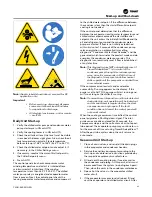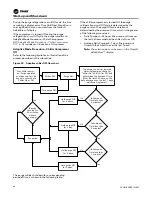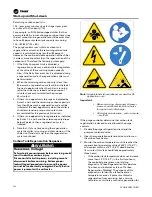
100
CVHH-SVX001G-EN
Figure 60.
Purge operating limits
120 (48.8)
100 (37.8)
80 (26.7)
60 (15.6)
40 (4.4)
20 (-6.7)
0 (-17.8)
0
(-17.8)
20
(-6.7)
40
(4.4)
60
(15.6)
80
(26.7)
100
(37.8)
120
(48.8)
140
(60.0)
160
(71.1)
A
mbient
T
empe
r
a
ture,
°F
(°C
)
Chiller Condenser Saturation Temperature, °F (°C)
Operating envelope extremes
Typical operation
Pumpout can be
inhibited in this
range according to
control settings.
Air Removal
If no air is in the purge tank, the refrigerant returning to
the purge condensing unit compressor suction has a
high
superheat
(heat added past the point of
evaporation), because of the heat removed from the
condensing chiller refrigerant vapor in the purge tank.
As air accumulates in the purge tank, it displaces the
chiller refrigerant vapor and decreases the amount of
coil surface that is exposed to the vapor. Less heat is
removed from the vapor, and the available superheat
at the purge condensing unit compressor suction
consequently falls. When the purge refrigerant
compressor suction temperature falls far enough to
reach the pump-out initiate value, the purge control
activates the solenoids and the pump-out compressor
to remove the accumulated air.
As air is removed from the purge tank, the inside coil is
once again exposed to chiller refrigerant vapor. As
more chiller refrigerant vapor condenses on the coil,
more heat is removed from the vapor, and the purge
refrigerant compressor suction temperature rises. The
purge control cycles or stops the pump-out process in
response to the compressor suction temperature.
Pump-out Operating Sequence
As the purge control system detects the presence of
non-condensables in the purge tank, it initiates a
pump-out cycle. The pump-out solenoid valve, the
exhaust solenoid valve, and the pump-out compressor
cycle On and Off as needed to remove the non-
condensables.
Non-condensable Pump-out Algorithm
The controller uses the non-condensable pump-out
algorithm to determine when to initiate, control, and
terminate a pump-out cycle to remove air from the
purge tank. The purge refrigerant compressor suction
temperature sensor serves as the feedback to this
control algorithm. The compressor suction
temperature pump-out initiate and pump-out terminate
values are calculated by the purge control and are a
function of the purge liquid temperature.
The refrigerant used in the purge refrigeration circuit,
R-513A, is metered into the purge tank coil by a
constant-pressure regulating expansion valve. The
valve automatically controls the purge suction pressure
at a constant value of 21.5 psia (148.2 kPaA). Therefore,
refrigerant is metered into the coil as a two-phase
refrigerant mixture at a constant saturation
temperature of approximately -3°F (-19.4°C).
The cold coil creates a low vapor pressure near its
outside surface, which draws refrigerant from the
chiller condenser into the purge tank and to the coil
surface. When the refrigerant gets close enough to the
coil surface, it condenses into a liquid. Since liquid
refrigerant requires less volume than it does in a
gaseous form, additional refrigerant enters the purge
tank to fill the void and, in turn, condenses. This
mechanism is known as a
thermal siphon
.
As the chiller refrigerant condenses, heat is transferred
into the purge coil through the latent heat of
condensation. The compressor suction temperature
sensor monitors this heat transfer.
Air and other gases carried with the chiller refrigerant
vapor do not condense on the coil. Instead, they
accumulate in the purge tank, effectively acting to
insulate and inhibit the flow of refrigerant to the cold
coil surface. The thermal siphon rate is reduced and,
consequently, so is the amount of heat transfer. A
corresponding reduction occurs in the temperature of
the purge refrigerant exiting the coil. The compressor
suction temperature sensor monitors this temperature.
Summary of Contents for CVHH CenTraVac
Page 126: ...126 CVHH SVX001G EN N No ot te es s ...
















































